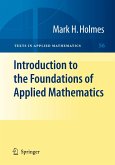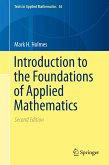Concentrates on how to make predictions about the numbers of each kind of basic state of a quantum system from only two ingredients: the symmetry and linear model of quantum mechanics Method has wide applications in crystallography, atomic structure, classification of manifolds with symmetry and other areas Engaging and vivid style Driven by numerous exercises and examples Systematic organization Separate solutions manual available
This is a textbook for a senior-level undergraduate course for math, physics and chemistry majors. This one course can play two different but complimentary roles: it can serve as a capstone course for students finishing their education, and it can serve as motivating story for future study of mathematics. Some textbooks are like a vigorous regular physical training program, preparing people for a wide range of challenges by honing their basic skills thoroughly. Some are like a series of day hikes. This book is more like an intended trek to a particularly beautiful goal. We'll take the easiest route to the top, and we'll stop to appreciate local flora as well as distant peaks worthy of the vigorous training one would need to scale them. Advice to the Student: This book was written with many different readers in mind. Some will be mathematics students interested to see a beautiful and powerful application of a "pure" mathematical subject. Some will be students of physics and chemistry curious about the mathematics behind some tools they use, such as spherical harmonics. Because the readership is so varied, no single reader should be put off by occasional digressions aimed at certain other readers.
Hinweis: Dieser Artikel kann nur an eine deutsche Lieferadresse ausgeliefert werden.
This is a textbook for a senior-level undergraduate course for math, physics and chemistry majors. This one course can play two different but complimentary roles: it can serve as a capstone course for students finishing their education, and it can serve as motivating story for future study of mathematics. Some textbooks are like a vigorous regular physical training program, preparing people for a wide range of challenges by honing their basic skills thoroughly. Some are like a series of day hikes. This book is more like an intended trek to a particularly beautiful goal. We'll take the easiest route to the top, and we'll stop to appreciate local flora as well as distant peaks worthy of the vigorous training one would need to scale them. Advice to the Student: This book was written with many different readers in mind. Some will be mathematics students interested to see a beautiful and powerful application of a "pure" mathematical subject. Some will be students of physics and chemistry curious about the mathematics behind some tools they use, such as spherical harmonics. Because the readership is so varied, no single reader should be put off by occasional digressions aimed at certain other readers.
Hinweis: Dieser Artikel kann nur an eine deutsche Lieferadresse ausgeliefert werden.
From the reviews: "Here is another book which is centered around the SO(4)-invariance of the 1/r potential. ... the present author always remains on a very solid mathematical ground. ... The author prepares carefully the mathematical ingredients (Hilbert spaces, Lie groups, Lie algebras, representations). The style of this senior-level undergraduate text is very fluent and - in the best sense - entertaining." (Evelyn Weimar-Woods, Zentralblatt MATH, Vol. 1088 (14), 2006) "It is an introductory textbook on the unitary representation theory of Lie groups, with emphasis on the important groups SO (3), SU (2), and SO (4), with the hydrogen atom as a motivating, unifying theme. The intended audience is senior-level undergraduate majors in mathematics, physics, and chemistry. Numerous exercises are provided. ... will recommend the book as supplementary reading to those students who desire to understand the mathematics at a deeper level. ... Singer's book is a very good one for undergraduate mathematics majors." (Stephen A. Fulling, American Mathematical Monthly, Vol. 114, August-September, 2007)








